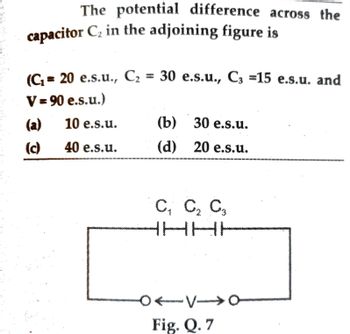Question

Transcribed Image Text:The potential difference across the
capacitor C₂ in the adjoining figure is
(C₁= 20 e.s.u., C₂ = 30 e.s.u., C3 =15 e.s.u. and
V = 90 e.s.u.)
(a)
10 e.s.u.
(b) 30 e.s.u.
(c)
40 e.s.u.
(d) 20 e.s.u.
C₁ C₂ C3
0←V→→→→0
Fig. Q. 7
Expert Solution
This question has been solved!
Explore an expertly crafted, step-by-step solution for a thorough understanding of key concepts.
Step by stepSolved in 2 steps

Knowledge Booster
Similar questions
- In a linear particle accelerator electrons are accelerated from rest to a speed of approximately the speed of light (3 x 108 m/s). If point A is the initial position of the electrons in the machine and point B is the position at which they reach their final speed, what is the electrical potential difference VA - VB in MV?arrow_forwardA 4.50 pF capacitor is connected in series with a 3.00 pF capacitor and a 350 V potential difference is applied across the pair. (a) What is the charge on each capacitor (in nC)? 4.50 pF саpасitor 6.3e-10 X nC 3.00 pF сараcitor 6.3е-10 X nC (b) What is the voltage across each capacitor (in V)? 4.50 pF сараcitor V 3.00 pF сараcitor Varrow_forwardAn ideal air-filled parallel plate capacitor with plate a separation of 4.0 cm has a plate area of 0.040 m2. What is the capacitance of this capacitor with air between these plates? (ɛ0 = 8.85 × 10-12 C2/N • m2) 89 pF 8.9 pF 0.89 pF 8.9 μarrow_forward
- If & 1 = 4.0 V, & 2 = 12.0 V, R₁ = 42, R₂ = 122, C = 3 μF, Q = 18 µC, and I = 2.5 A, what is the potential difference V₁ - Vb? R₁ +11 &₁ bow ! R₂ - 30 V O 30 V O 5.0 V & = O -5.0 V 1₁ e 30arrow_forwardThe graph and data of experimental equipotential lines for an electric dipole consisting of 2 opposite charges is shown below: D-D + + + + + ++ + ++ + to + + + G + ++ 4. A + + 14 + + 9 + %23 + e + + + +4 + O + + + ++ +4 ++ + + + + + + ++ ++ + ++ + ++ +++ 4. + + AIN 245 U + + + ++ +++ + + + + + +/+ + /+ + ++ + + + + + + + + +\+ + + + to -+ + + ++ + ++ + + + + ++ + + + + + + + + + A + + -2 Initial Point Voltage Δν Ad (m) |El=(AV/Ad) [v/m] 1 1.05 V 2 1.81 V 0.75 0.02 37.5 3 2.45 V 0.64 0.02 32.0 4 3.15 V 0.70 0.02 35.0 5 3.92 V 0.77 0.02 38.5 1. If you drop a charge on this line, will it move? 2. Will it move along the electric field line or the equipotential line?arrow_forwardConsider what happens when a person moves around in dry conditions. The rubbing of motion leads to static electric charge building up on the body. Assume the capacitance of the human body to be about 155 pF. a) How much charge would have to build up on a body to generate a potential difference of 10 kV? b) A particular cell phone can have its circuits destroyed if exposed to an electric shock containing 300 u.J of energy. What voltage does that correspond to if the shock is coming from a human body?arrow_forward
arrow_back_ios
arrow_forward_ios